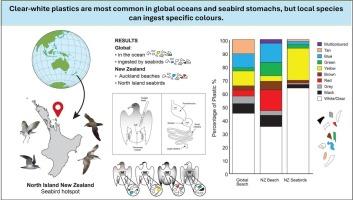透明白色的塑料在全球海洋和海鸟的胃中最常见,但当地物种可以摄入特定的颜色
IF 4.9
3区 环境科学与生态学
Q1 ENVIRONMENTAL SCIENCES
引用次数: 0
摘要
塑料是海鸟的主要威胁,摄入塑料可能涉及感官陷阱,即海洋塑料的气味和外观可能与食物相似,或者利用了动物原有的感官偏差。我们对全球文献的调查显示,透明白色塑料是海洋中最常见的塑料颜色,也是海鸟摄取最多的塑料。然而,我们在海鸟多样性热点地区(新西兰奥特亚罗瓦北部)进行的案例研究表明,虽然清白色塑料也是海滩上最常见的颜色,但当地海鸟摄取塑料的颜色模式更具物种特异性。我们对 13 种海鸟(8 种海燕、4 种剪切鸥和 1 种箴言鸟,共 72 只)的解剖结果表明,虽然它们经常摄食清白色塑料,但摄食其他颜色塑料的次数或多或少超出了预期,因为这些颜色塑料在环境中相对容易获得。其他海鸟可能也会优先摄取特定颜色的塑料,但全球范围的分析可能会掩盖特定区域或物种的模式。对摄入塑料的光谱波长测量(辐射)显示出人类看不见的波长,如紫外线(紫外线辐射),这表明海鸟对某些塑料可能存在感官偏差。这强调了在了解海鸟摄取塑料时考虑物种行为和视觉感知差异的重要性。本文章由计算机程序翻译,如有差异,请以英文原文为准。

Clear-white plastics are most common in global oceans and seabird stomachs, but local species can ingest specific colours
Plastic is a major threat to seabirds and the ingestion of plastic may involve a sensory trap, where the odours and appearance of marine plastics can resemble food, or exploit animals' pre-existing sensory biases. Our global survey of the literature reveals that clear-white plastic is the most common plastic colour found in the ocean and is also most ingested by seabirds. However, our case study in a seabird diversity hotspot (northern Aotearoa New Zealand) indicates that although clear-white plastic is also the most common colour found on beaches, local seabirds have more species-specific colour patterns in plastic ingestion. Our dissections of 13 species of Procellariiformes (eight petrels, four shearwaters and one prion, n = 72 individuals in total) revealed that although they often ate clear-white plastics, other colours were ingested more or less often than expected given their relative availability in the environment. Other seabirds may also preferentially ingest specific plastic colours, but region- or species-specific patterns may be hidden by global scale analyses. Spectral wavelength measurements (radiation) of the ingested plastics reveal wavelengths invisible to humans, e.g. UV (ultraviolet radiation), indicates potential sensory biases in seabirds towards certain plastics. This emphasises the importance of considering species differences in behaviour and visual perception in understanding seabird plastic ingestion.
求助全文
通过发布文献求助,成功后即可免费获取论文全文。
去求助
来源期刊

Marine pollution bulletin
环境科学-海洋与淡水生物学
CiteScore
10.20
自引率
15.50%
发文量
1077
审稿时长
68 days
期刊介绍:
Marine Pollution Bulletin is concerned with the rational use of maritime and marine resources in estuaries, the seas and oceans, as well as with documenting marine pollution and introducing new forms of measurement and analysis. A wide range of topics are discussed as news, comment, reviews and research reports, not only on effluent disposal and pollution control, but also on the management, economic aspects and protection of the marine environment in general.
 求助内容:
求助内容: 应助结果提醒方式:
应助结果提醒方式:


